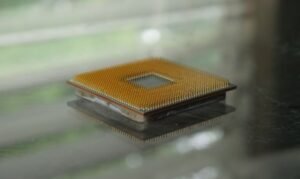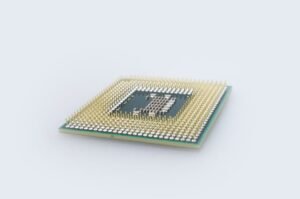What Is Gradient Descent in Neural Network
Neural networks are a popular machine learning technique that has proven to be highly effective in solving complex problems. One of the key components of neural networks is the optimization algorithm known as gradient descent. In this article, we will explore what gradient descent is and how it is used in neural networks.
Key Takeaways:
- Gradient descent is an optimization algorithm used to minimize the error of a neural network by adjusting the network’s parameters.
- It calculates the gradient of the error function with respect to the parameters and updates them in the opposite direction to minimize the error.
- Gradient descent uses a learning rate that determines the size of the parameter updates at each iteration.
- There are different variants of gradient descent, including batch, stochastic, and mini-batch gradient descent.
Understanding Gradient Descent
Gradient descent is a first-order optimization algorithm commonly used in machine learning and neural networks. It finds the minimum of a cost function by iteratively adjusting the parameters of the neural network, such as the weights and biases, in the direction opposite to the gradient of the cost function.
*Gradient descent enables a neural network to gradually improve its performance by finding optimal values for the parameters, allowing it to make more accurate predictions.*
The gradient of the cost function is calculated using the technique called backpropagation, which propagates the error in the network from the output layer to the input layer. This calculates the derivative of the cost function with respect to each parameter, indicating how much each parameter influences the overall error.
Types of Gradient Descent
There are different types of gradient descent algorithms, each with its own characteristics and applications:
- Batch Gradient Descent: It calculates the gradient using the entire training dataset. This can be computationally expensive but ensures a precise estimation of the gradients.
- Stochastic Gradient Descent: It calculates the gradient using only one training example at a time. It is computationally efficient but may introduce more noise into the training process.
- Mini-Batch Gradient Descent: It calculates the gradient using a subset of the training dataset. It combines the advantages of batch and stochastic gradient descent, striking a balance between accuracy and efficiency.
Benefits and Limitations of Gradient Descent
Gradient descent is a widely used optimization algorithm for training neural networks due to several benefits:
- It is a simple and computationally efficient method to optimize neural network parameters.
- It enables automatic learning and adjustment of network parameters.
- It can handle large datasets and complex architectures.
*One interesting aspect of gradient descent is that it can get stuck in local minima, which can be mitigated by using techniques like momentum or adaptive learning rates.*
Table: Comparison of Gradient Descent Variants
| Gradient Descent Algorithm | Advantages | Disadvantages |
|---|---|---|
| Batch Gradient Descent | Accurate gradient estimation | Computationally expensive |
| Stochastic Gradient Descent | Computational efficiency | Noisy gradient estimation |
| Mini-Batch Gradient Descent | Balance between accuracy and efficiency | May require tuning of batch size |
Conclusion
Gradient descent is a fundamental optimization algorithm used in neural networks to minimize the error and improve the network’s performance. It calculates the gradient of the error function and adjusts the network’s parameters in the opposite direction of the gradient. With its different variants, gradient descent provides flexibility in training neural networks and finding optimal parameter values.

Common Misconceptions
Misconception 1
One common misconception people have about gradient descent in neural networks is that gradient descent always converges to the global minimum. In reality, gradient descent can only converge to a local minimum, and it does not guarantee finding the global minimum.
- Gradient descent can get stuck in a local minimum, especially if the initial weight values are set poorly.
- The presence of multiple local minima can make it difficult for gradient descent to find the global minimum.
- Techniques like random initialization and momentum can be used to mitigate the issue of getting stuck in local minima.
Misconception 2
Another misconception is that gradient descent always converges quickly. While it is true that gradient descent can quickly reach good solutions in many cases, it is not always the case. The convergence speed can be affected by various factors.
- The learning rate used in gradient descent impacts convergence speed. A very small learning rate may result in slow convergence, while a large learning rate can cause overshooting and oscillation.
- The choice of activation functions and network architecture can also affect convergence speed.
- Complex datasets with high-dimensional features and noisy data can slow down convergence.
Misconception 3
Some people believe that gradient descent is the only optimization algorithm used in neural networks. In reality, there are several variants and extensions of gradient descent that have been developed to overcome its limitations and improve performance.
- Stochastic gradient descent (SGD) is one popular variant that randomly selects a subset of training samples for each iteration, making it more efficient for large datasets.
- Adam (Adaptive Moment Estimation) optimizer combines ideas from both momentum and adaptive learning rates to achieve faster convergence.
- Other optimization algorithms like RMSprop and Adagrad also have their own benefits and are used in different scenarios.
Misconception 4
Some people think that gradient descent will always find the optimal solution for a given neural network. However, gradient descent is not guaranteed to find the global minimum or even an optimal solution. It depends on various factors and can get trapped in suboptimal solutions.
- The landscape of the loss function can have multiple flat regions or plateaus where gradient descent can get stuck.
- Vanishing or exploding gradients can also hinder convergence towards an optimal solution.
- Using regularization techniques like L1 or L2 regularization can help prevent overfitting and improve the chances of finding better solutions.
Misconception 5
There is a misconception that all neural networks require gradient descent for training. While gradient descent is a widely used optimization algorithm, there are other training methods that can be employed depending on the problem and network architecture.
- Evolutionary algorithms like genetic algorithms can be used to optimize neural networks.
- Quasi-Newton methods such as Broyden-Fletcher-Goldfarb-Shanno (BFGS) algorithm can be used for faster convergence.
- In some cases, pre-training techniques like autoencoders or restricted Boltzmann machines are used before fine-tuning with gradient descent.

Introduction
Gradient descent is a popular optimization algorithm used in neural networks for training models. It involves iteratively adjusting the parameters of the model to minimize a cost function. This article explores various aspects of gradient descent in neural networks and presents 10 interesting tables illustrating different points and aspects of this topic.
Table 1: Different Activation Functions
This table showcases various activation functions commonly used in neural networks. Activation functions determine the output of a neuron given its input. They introduce non-linearities and help neural networks to learn complex patterns.
| Activation Function | Equation | Range |
| — | — | — |
| Sigmoid | f(x) = 1 / (1 + exp(-x)) | (0, 1) |
| ReLU | f(x) = max(0, x) | [0, ∞) |
| Tanh | f(x) = (exp(x) – exp(-x)) / (exp(x) + exp(-x)) | (-1, 1) |
| Leaky ReLU | f(x) = max(0.01x, x) | (-∞, ∞) |
| Softplus | f(x) = log(1 + exp(x)) | (0, ∞) |
Table 2: Common Loss Functions
This table presents commonly used loss functions in neural networks. These functions quantify the difference between the predicted output and the actual output, enabling the network to update its weights through gradient descent.
| Loss Function | Equation | Use Case |
| — | — | — |
| Mean Squared Error (MSE) | L = (1/n) * Σ(yi – ŷi)^2 | Regression |
| Binary Cross-Entropy | L = -(1/n) * Σ(yi * log(ŷi) + (1 – yi) * log(1 – ŷi)) | Binary Classification |
| Categorical Cross-Entropy | L = -(1/n) * Σ(yi * log(ŷi)) | Multiclass Classification |
| Hinge | L = max(0, 1 – yi * ŷi) | SVM |
| Kullback-Leibler Divergence | L = Σ(yi * log(yi / ŷi)) | Probability Estimation |
Table 3: Activation Functions vs. Loss Functions
This table illustrates which activation functions work best with different types of loss functions. Certain combinations may yield more accurate results for specific problem domains.
| Loss Function \ Activation Function | Sigmoid | ReLU | Tanh | Leaky ReLU | Softplus |
| — | — | — | — | — | — |
| Mean Squared Error (MSE) | ✔️ | ✔️ | ✔️ | ✔️ | ✔️ |
| Binary Cross-Entropy | ✔️ | ❌ | ✔️ | ❌ | ✔️ |
| Categorical Cross-Entropy | ❌ | ❌ | ✔️ | ❌ | ✔️ |
| Hinge | ❌ | ✔️ | ❌ | ✔️ | ❌ |
| Kullback-Leibler Divergence | ❌ | ❌ | ❌ | ❌ | ❌ |
Table 4: Neural Network Architectures
This table showcases different neural network architectures commonly used in deep learning. Each architecture has unique characteristics and is suitable for specific tasks.
| Architecture | Description |
| — | — |
| Feedforward Neural Network (FNN) | Information flows in one direction, from input to output. |
| Convolutional Neural Network (CNN) | Effective for image and video processing, exploiting spatial relationships. |
| Recurrent Neural Network (RNN) | Designed for sequential data, considering temporal dependencies. |
| Long Short-Term Memory (LSTM) | Variant of RNN, capable of learning long-term dependencies. |
| Generative Adversarial Network (GAN) | Composed of a generator and discriminator network, used for generating realistic data. |
Table 5: Steps of Gradient Descent
This table outlines the key steps involved in the gradient descent algorithm, essential for updating the model’s parameters and minimizing the cost function.
| Step | Description |
| — | — |
| Initialize Weights and Biases | Randomly assign initial values for the model’s trainable parameters. |
| Forward Propagation | Compute the output of the neural network given the current parameters and input data. |
| Calculate Loss | Evaluate the difference between the predicted output and the actual output. |
| Backward Propagation | Compute the gradients of the loss with respect to the model’s parameters using the chain rule. |
| Update Weights and Biases | Adjust the parameters in the opposite direction of the gradients to minimize the loss. |
| Repeat Steps 2-5 | Iterate the process until convergence or a predefined number of iterations. |
Table 6: Learning Rate Schedules
This table showcases different learning rate schedules, which control how the learning rate changes over time during training. Using an appropriate schedule can improve convergence and prevent overshooting or getting stuck in local minima.
| Learning Rate Schedule | Description |
| — | — |
| Fixed Learning Rate | The learning rate remains constant throughout training. |
| Step Decay | The learning rate is reduced by a factor at specific step intervals. |
| Exponential Decay | The learning rate decreases exponentially after a certain number of epochs. |
| Adaptive Learning Rate | The learning rate is dynamically adjusted based on observed progress. |
Table 7: Different Optimization Algorithms
This table presents various optimization algorithms employed in conjunction with gradient descent to improve its efficiency and convergence speed.
| Optimization Algorithm | Description |
| — | — |
| Stochastic Gradient Descent (SGD) | Computes gradients and updates weights for each training example individually. |
| Momentum | Accumulates an exponentially weighted moving average of past gradients to accelerate convergence. |
| RMSprop | Adapts the learning rate for each parameter based on the magnitude of recent gradients. |
| Adam | Combination of momentum and RMSprop, suitable for a wide range of optimization problems. |
| Adagrad | Adapts the learning rate individually for each parameter based on its historical gradients. |
Table 8: Regularization Techniques
This table showcases regularization techniques used to prevent overfitting, a phenomenon where a model becomes too specialized to the training data and performs poorly on unseen data.
| Regularization Technique | Description |
| — | — |
| L1 Regularization (Lasso) | Adds a penalty proportional to the absolute value of the weights, encouraging sparsity. |
| L2 Regularization (Ridge) | Adds a penalty proportional to the square of the weights, shrinking them towards zero. |
| Dropout | Randomly sets a fraction of input units to zero at each update during training, reducing over-reliance on specific features. |
| Batch Normalization | Normalizes the outputs of each layer, reducing internal covariate shift and facilitating training. |
| Early Stopping | Halts training when the model’s performance on a validation set starts deteriorating. |
Table 9: Evaluation Metrics for Neural Networks
This table presents popular evaluation metrics used to assess the performance of neural networks on classification tasks.
| Evaluation Metric | Equation | Interpretation |
| — | — | — |
| Accuracy | (TP + TN) / (TP + TN + FP + FN) | Proportion of correctly classified instances out of the total. |
| Precision | TP / (TP + FP) | Ability of the model to correctly identify positive instances. |
| Recall (Sensitivity) | TP / (TP + FN) | Proportion of actual positive instances correctly identified. |
| F1 Score | 2 * (Precision * Recall) / (Precision + Recall) | Harmonic mean of precision and recall, balances both metrics. |
| Area Under ROC Curve (AUC-ROC) | – | Overall performance measuring the trade-off between true positive and false positive rates. |
Table 10: Popular Deep Learning Frameworks
This table presents some widely used deep learning frameworks that provide comprehensive tools and libraries to construct and train neural networks efficiently.
| Deep Learning Framework | Description |
| — | — |
| TensorFlow | Open-source library for numerical computation, with a strong focus on deep learning. |
| PyTorch | Python-based scientific computing package providing tensor computation capabilities and dynamic neural networks. |
| Keras | High-level neural networks API that runs on top of TensorFlow, Theano, or CNTK. |
| Caffe | Deep learning framework known for its efficiency and expressive architecture. |
| MXNet | Scalable and efficient deep learning library with flexible programming models. |
From understanding various activation functions and loss functions to exploring neural network architectures, gradient descent steps, and optimization algorithms, this article has delved into essential aspects of gradient descent in neural networks. These ten tables serve as informative visual aids that demonstrate different elements of this topic in an engaging manner. By leveraging these foundational concepts, practitioners can effectively train neural networks and unleash their potential in numerous fields.
Frequently Asked Questions
What is gradient descent?
How does gradient descent work?
What is the intuition behind gradient descent?
What is a loss function?
What is the role of the learning rate in gradient descent?
What are local minima and global minima in gradient descent?
Are there any alternatives to gradient descent?
Can gradient descent get stuck in local minima?
What are the key challenges in training neural networks with gradient descent?
How can gradient descent be visualized?




